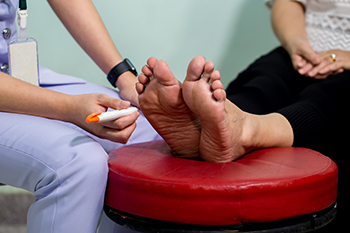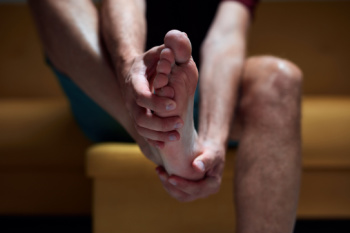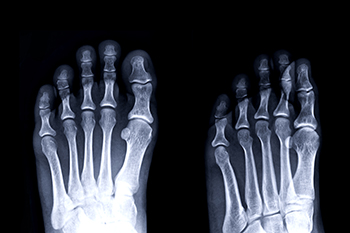
Diabetic peripheral neuropathy is a common issue for individuals with type 2 diabetes, with nearly half experiencing this complication. This condition arises when prolonged high blood sugar levels cause damage to the nerves, especially in the feet and lower legs. Symptoms of peripheral neuropathy include numbness, tingling, burning sensations, and muscle weakness, which can progressively disrupt daily activities. A significant concern is “diabetic foot,” where the loss of feeling and poor blood flow can lead to ulcers, infections, and in severe cases loss of limb. Diabetic neuropathy also can increase the risk of falls and fractures due to lack of sensation in the feet, impaired balance and reduced coordination. Factors such as smoking, high blood pressure, obesity, and cholesterol issues can further increase the risk of developing this diabetic peripheral neuropathy. Early detection and proper management are of extreme importance. If you notice unusual sensations in your feet or lower legs, especially persistent numbness or pain, it is suggested that you make an appointment with a podiatrist who can conduct a thorough examination and recommend a personalized treatment plan.
Neuropathy
Neuropathy can be a potentially serious condition, especially if it is left undiagnosed. If you have any concerns that you may be experiencing nerve loss in your feet, consult with one of our podiatrists from Jill Einhorn, DPM and James Einhorn, DPM. Our doctors will assess your condition and provide you with quality foot and ankle treatment for neuropathy.
What Is Neuropathy?
Neuropathy is a condition that leads to damage to the nerves in the body. Peripheral neuropathy, or neuropathy that affects your peripheral nervous system, usually occurs in the feet. Neuropathy can be triggered by a number of different causes. Such causes include diabetes, infections, cancers, disorders, and toxic substances.
Symptoms of Neuropathy Include:
Those with diabetes are at serious risk due to being unable to feel an ulcer on their feet. Diabetics usually also suffer from poor blood circulation. This can lead to the wound not healing, infections occurring, and the limb may have to be amputated.
Treatment
To treat neuropathy in the foot, podiatrists will first diagnose the cause of the neuropathy. Figuring out the underlying cause of the neuropathy will allow the podiatrist to prescribe the best treatment, whether it be caused by diabetes, toxic substance exposure, infection, etc. If the nerve has not died, then it’s possible that sensation may be able to return to the foot.
Pain medication may be issued for pain. Electrical nerve stimulation can be used to stimulate nerves. If the neuropathy is caused from pressure on the nerves, then surgery may be necessary.
If you have any questions, please feel free to contact our offices located in Brooklyn and Astoria, NY . We offer the newest diagnostic and treatment technologies for all your foot care needs.
 Wearing the right shoes is essential for maintaining foot health and preventing various foot problems. Ill-fitting shoes can lead to or worsen conditions such as bunions, calluses, corns, and deformities like hammer, claw, or mallet toes. These issues not only cause discomfort but can become more problematic if not addressed. Properly fitted footwear plays a significant role in relieving pain caused by foot deformities and joint problems. It also helps prevent these issues from progressing and can aid in the recovery process post-surgery. When selecting new shoes, try them on later in the day when your feet are the largest. It is important to measure both feet and choose the larger size if they differ. Shoes should have a wide, deep-toe box, a low heel, and a supportive sole. They should also allow your toes to move freely and fit snugly in the widest part of the shoe. If you have problems that may be the result of wearing ill-fitting shoes, it is suggested that you schedule an appointment with a podiatrist for an exam, diagnosis, and treatment options.
Wearing the right shoes is essential for maintaining foot health and preventing various foot problems. Ill-fitting shoes can lead to or worsen conditions such as bunions, calluses, corns, and deformities like hammer, claw, or mallet toes. These issues not only cause discomfort but can become more problematic if not addressed. Properly fitted footwear plays a significant role in relieving pain caused by foot deformities and joint problems. It also helps prevent these issues from progressing and can aid in the recovery process post-surgery. When selecting new shoes, try them on later in the day when your feet are the largest. It is important to measure both feet and choose the larger size if they differ. Shoes should have a wide, deep-toe box, a low heel, and a supportive sole. They should also allow your toes to move freely and fit snugly in the widest part of the shoe. If you have problems that may be the result of wearing ill-fitting shoes, it is suggested that you schedule an appointment with a podiatrist for an exam, diagnosis, and treatment options.
Finding a properly-fitting shoe is important in reducing injuries and preventing foot problems. For more information about treatment, contact one of our podiatrists from Jill Einhorn, DPM and James Einhorn, DPM. Our doctors will treat your foot and ankle needs.
Proper Shoe Fitting
A common concern when it comes to foot health, having properly fitted shoes can help prevent injuries to the foot. Out feet affect our posture and gait, which in turn affects the biomechanics and overall bodily structure. With 33 joints, 26 bones, and over 100 ligaments, the potential for serious injury is much greater than one realizes. Although the feet cease growth in adulthood, they still change shape as they mature. Here are some factors to consider when it comes to investing in proper fitting shoes:
Keeping in mind how shoes fit the biomechanics of your body, properly-fitting shoes are vitally important. Fortunately, it is not difficult to acquire footwear that fits correctly. Be sure to wear shoes that support the overall structure of your body. Do your feet a favor and invest in several pairs of well-fitted shoes today.
If you have any questions please feel free to contact our offices located in Brooklyn and Astoria, NY . We offer the newest diagnostic and treatment technologies for all your foot and ankle needs.

An Achilles tendon tear, whether partial or complete, is a serious injury often caused by sudden, forceful movements during sports or activities. Symptoms of an Achilles tendon tear include sharp pain, swelling, bruising, and difficulty pointing the foot or standing on tiptoe. Treatment options vary depending on the severity of the tear. Partial tears can often be managed conservatively with immobilization using a cast, splint, brace, or walking boot. This is followed by a structured rehabilitation program to restore strength and flexibility gradually. Complete tears typically require surgical intervention to reattach the tendon ends and ensure optimal healing. Following surgery, a thorough rehabilitation plan is essential to regain full function and reduce the risk of re-injury. If you suspect an Achilles tendon tear or experience symptoms like sudden pain and restricted movement, it is suggested that you seek an appointment with a podiatrist for a full exam and tailored treatment plan.
Achilles tendon injuries need immediate attention to avoid future complications. If you have any concerns, contact one of our podiatrists of Jill Einhorn, DPM and James Einhorn, DPM. Our doctors can provide the care you need to keep you pain-free and on your feet.
What Is the Achilles Tendon?
The Achilles tendon is a tendon that connects the lower leg muscles and calf to the heel of the foot. It is the strongest tendon in the human body and is essential for making movement possible. Because this tendon is such an integral part of the body, any injuries to it can create immense difficulties and should immediately be presented to a doctor.
What Are the Symptoms of an Achilles Tendon Injury?
There are various types of injuries that can affect the Achilles tendon. The two most common injuries are Achilles tendinitis and ruptures of the tendon.
Achilles Tendinitis Symptoms
Rupture Symptoms
Treatment and Prevention
Achilles tendon injuries are diagnosed by a thorough physical evaluation, which can include an MRI. Treatment involves rest, physical therapy, and in some cases, surgery. However, various preventative measures can be taken to avoid these injuries, such as:
If you have any questions please feel free to contact our offices located in Brooklyn and Astoria, NY . We offer the newest diagnostic tools and technology to treat your foot and ankle needs.
 Heel pain, often linked to conditions such as plantar fasciitis, is a prevalent complaint that affects the bottom or back of the heel. This pain typically results from inflammation, overuse, or injury to the plantar fascia, a thick band of tissue that supports the arch of the foot. Factors contributing to heel pain include excessive walking or standing, wearing improper footwear, obesity, and age-related changes. The pain is usually sharp and most intense during the first steps in the morning or after long periods of rest. It can significantly interfere with daily activities, making walking, exercising, and even standing difficult. Diagnosis involves a physical examination, patient history, and sometimes imaging tests like X-rays or MRI scans to rule out fractures or other issues. Treatment typically includes rest, anti-inflammatory medications, and stretching exercises. Custom orthotics and targeted stretching exercises may also be recommended. If you have persistent or severe heel pain, it is suggested that you schedule an appointment with a podiatrist for specialized care and treatment.
Heel pain, often linked to conditions such as plantar fasciitis, is a prevalent complaint that affects the bottom or back of the heel. This pain typically results from inflammation, overuse, or injury to the plantar fascia, a thick band of tissue that supports the arch of the foot. Factors contributing to heel pain include excessive walking or standing, wearing improper footwear, obesity, and age-related changes. The pain is usually sharp and most intense during the first steps in the morning or after long periods of rest. It can significantly interfere with daily activities, making walking, exercising, and even standing difficult. Diagnosis involves a physical examination, patient history, and sometimes imaging tests like X-rays or MRI scans to rule out fractures or other issues. Treatment typically includes rest, anti-inflammatory medications, and stretching exercises. Custom orthotics and targeted stretching exercises may also be recommended. If you have persistent or severe heel pain, it is suggested that you schedule an appointment with a podiatrist for specialized care and treatment.
Many people suffer from bouts of heel pain. For more information, contact one of our podiatrists of Jill Einhorn, DPM and James Einhorn, DPM. Our doctors can provide the care you need to keep you pain-free and on your feet.
Causes of Heel Pain
Heel pain is often associated with plantar fasciitis. The plantar fascia is a band of tissues that extends along the bottom of the foot. A rip or tear in this ligament can cause inflammation of the tissue.
Achilles tendonitis is another cause of heel pain. Inflammation of the Achilles tendon will cause pain from fractures and muscle tearing. Lack of flexibility is also another symptom.
Heel spurs are another cause of pain. When the tissues of the plantar fascia undergo a great deal of stress, it can lead to ligament separation from the heel bone, causing heel spurs.
Why Might Heel Pain Occur?
Treatments
Heel pain should be treated as soon as possible for immediate results. Keeping your feet in a stress-free environment will help. If you suffer from Achilles tendonitis or plantar fasciitis, applying ice will reduce the swelling. Stretching before an exercise like running will help the muscles. Using all these tips will help make heel pain a condition of the past.
If you have any questions please contact our offices located in Brooklyn and Astoria, NY . We offer the newest diagnostic and treatment technologies for all your foot and ankle needs.

Metatarsal fractures refer to breaks or cracks in one or more of the five long bones in the foot that connect the ankle to the toes. These fractures often result from direct trauma, overuse, or severe twisting of the foot. Symptoms include pain, swelling, bruising, and difficulty bearing weight. Proper treatment is vital for healing, as improper or delayed treatment can lead to serious consequences. Without appropriate care, metatarsal fractures can result in chronic pain, improper bone healing, and long-term mobility issues. Misaligned bones can cause persistent discomfort and increase the risk of arthritis in the affected joints. Therefore, it is essential to seek prompt attention from a podiatrist, follow prescribed treatment plans, and allow adequate time for healing to prevent complications and ensure a full recovery. If you have believe you have fractured a metatarsal, it is strongly suggested that you visit a podiatrist for a diagnosis and treatment.
A broken foot requires immediate medical attention and treatment. If you need your feet checked, contact one of our podiatrists from Jill Einhorn, DPM and James Einhorn, DPM. Our doctors can provide the care you need to keep you pain-free and on your feet.
Broken Foot Causes, Symptoms, and Treatment
A broken foot is caused by one of the bones in the foot typically breaking when bended, crushed, or stretched beyond its natural capabilities. Usually the location of the fracture indicates how the break occurred, whether it was through an object, fall, or any other type of injury.
Common Symptoms of Broken Feet:
Those that suspect they have a broken foot shoot seek urgent medical attention where a medical professional could diagnose the severity.
Treatment for broken bones varies depending on the cause, severity and location. Some will require the use of splints, casts or crutches while others could even involve surgery to repair the broken bones. Personal care includes the use of ice and keeping the foot stabilized and elevated.
If you have any questions please feel free to contact our offices located in Brooklyn and Astoria, NY . We offer the newest diagnostic and treatment technologies for all your foot and ankle needs.